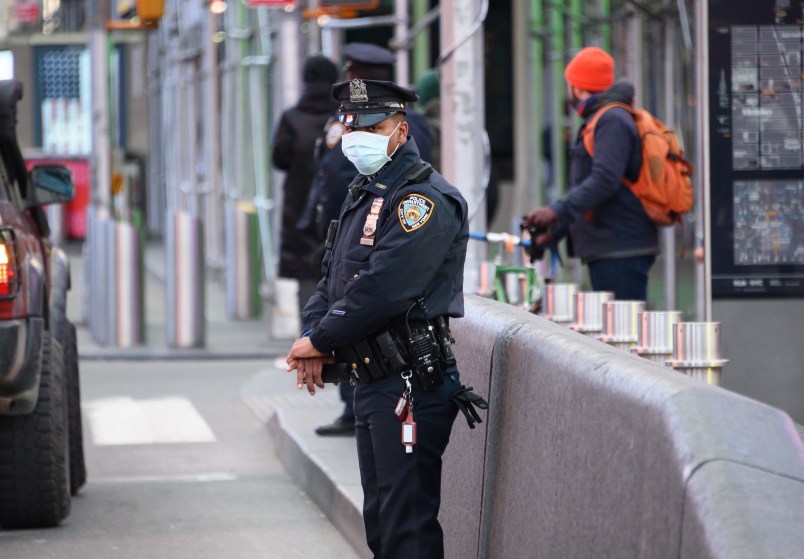Just days after New York leaders ordered people to stay home, authorities mobilized to head off a potential public health disaster Wednesday, the city’s emergence as the nation’s biggest coronavirus hot spot a warning flare for the rest of the country.
A makeshift morgue was set up outside Bellevue Hospital, and the city’s police, their numbers dwindling by the day as more fall sick, were told to patrol nearly empty streets to enforce social distancing.
Public health officials hunted down beds and medical equipment and put out a call for more doctors and nurses for fear the number of sick will explode in a matter of weeks, overwhelming hospitals the way the virus did in Italy and Spain.
Worldwide, the death toll climbed past 20,000, according to a running count kept by Johns Hopkins University. The number of dead in the U.S. topped 800, with more than 60,000 infections.
New York State alone accounted for more than 30,000 cases and close to 300 deaths, most of them in New York City.
Gov. Andrew Cuomo, again pleading for help in dealing with the coming onslaught, attributed the cluster to the city’s role as a gateway to international travelers and the sheer density of its population, with 8.6 million people sharing subways, elevators, apartment buildings and offices.
“Our closeness makes us vulnerable,” he said. “But it’s true that your greatest weakness is also your greatest strength. And our closeness is what makes us who we are. That is what New York is.”
In other developments around the globe:
— The White House and legislative leaders reached agreement on a mammoth economic relief package, a $2 trillion plan to help businesses survive the crisis and give households checks of $1,200 per adult and $500 per child. Stocks rallied on Wall Street for the second day in a row.
— Prince Charles, the 71-year-old heir to the British throne, tested positive for the virus but was showing only mild symptoms and was isolating himself at a royal estate in Scotland, his office said.
— Spain’s death toll rose past 3,400, eclipsing China’s, after a one-day spike of 700 fatalities. It is now second only to Italy, with over 7,500 deaths.
__ China’s Hubei province, where the outbreak first emerged late last year, started lifting its lockdown.
— Russian President Vladimir Putin postponed a nationwide vote on proposed constitutional amendments that could enable him to extend his hold on power. The decision came as Russia reported its first deaths from the virus, two elderly patients who had underlying conditions.
— The French Riviera city of Cannes opened the site of its world-famous film festival to the homeless.
More than 440,000 people worldwide have been infected overall, by Johns Hopkins’ count. More than 100,000 have recovered.
Other states braced for a version of New York’s nightmare, with fears over public events held in the weeks before the virus exploded.
A month after Mardi Gras in and around New Orleans, Louisiana is seeing a ballooning number of cases and now has the third-highest rate per capita in the U.S., according to the governor. Sixty-five Louisiana residents have died, and the virus has been confirmed in three-quarters of the state’s 64 parishes.
For most people, the coronavirus causes mild or moderate symptoms, such as fever and cough that clear up in two to three weeks. For some, especially older adults and people with existing health problems, it can cause more severe illness, including pneumonia.
___
Long reported from Washington. Associated Press reporters around the world contributed.







800 complaints were filed in Dallas yesterday about large gatherings. We live a couple of blocks from White Rock Lake which is a major recreation spot in the heart of the city and there were helicopters over the lake all day. I think they were trying to remind people to stay apart. The weather got beautiful here after two months of rain and people are outside in droves.
Dammit.
Showing no more awareness than 21 year olds on spring break on the beaches of south Florida.
Yeah just got back from my walk. Day 3 of the shelter in place order for St. Louis County and there were lots of people on the trail, so only a 4 deer day.
Now I did see a novel and correct way for a Dad to teach/have is son practice riding a bicycle. Kid rode with training wheels still on, while Dad was on his skateboard. So much better than Dad on bike and kid on bike, but can’t keep up with Dad.
After all the dog walking I saw I don’t think there’ll be any over weight pooches in the county.
That is novel. hahahaha Love how people are always thinking. hahaha
Read those words again–slowly.